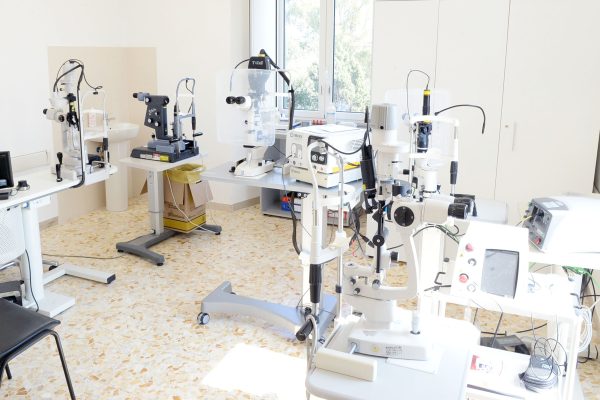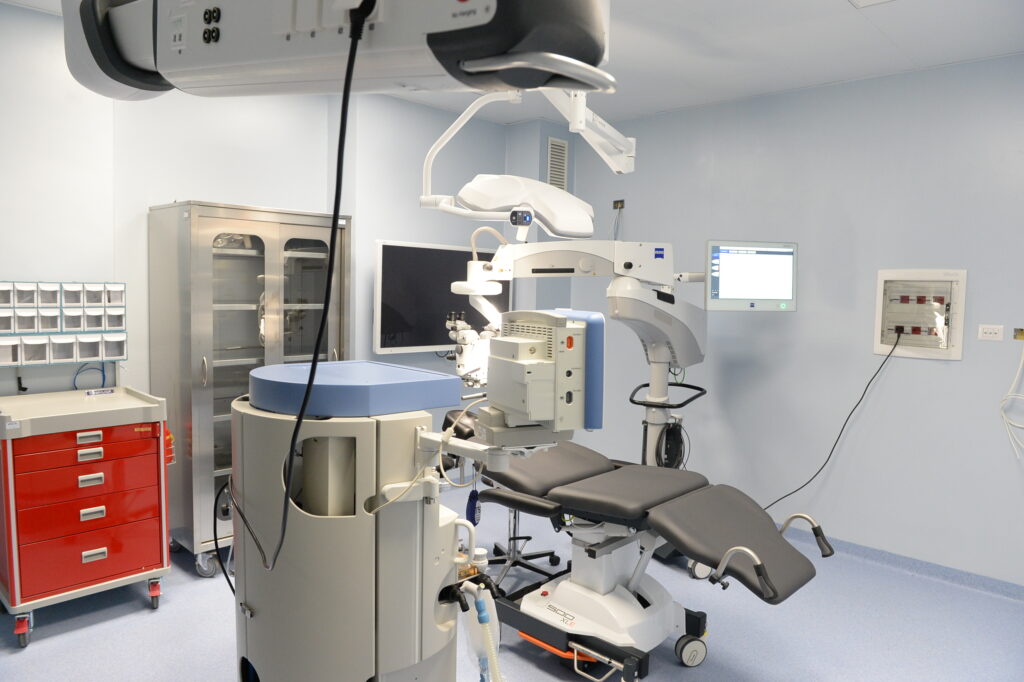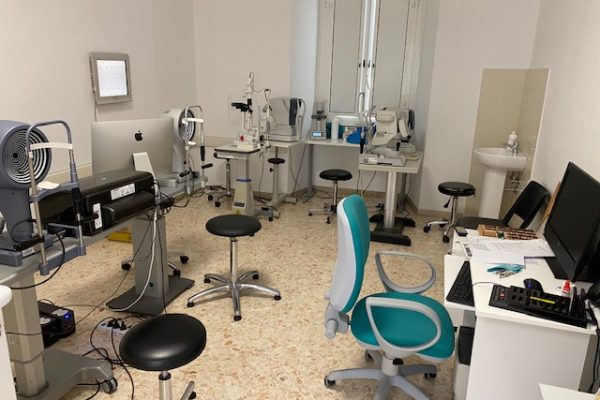TECHNOLOGIES



Ocular ultrasound is a diagnostic method that uses ultrasound to visualize the structures of the eye and orbit. Ocular ultrasound is of utmost use when direct exploration of the internal structures of the eye is not possible, for example due to corneal opacity, an advanced cataract or a vitreous hemorrhage. The clinical conditions most studied with this imaging technique are: retinal detachment or retinal breaks, choroid detachment, vitreous hemorrhages or endophthalmitis, advanced proliferative diabetic retinopathy in the presence of tractive membranes, intraocular solid tumors (choroidal melanomas, hemangiomas, metastases). It is also extremely important in the post-surgical follow-up of many of the conditions just listed. Orbital ultrasound allows, instead, to study the lacrimal gland, the oculomotor muscles, the optic nerve, and the other retro bulbar structures being able to represent, in selected cases and in expert hands, a valid alternative to CT and MRI.
Fluorescein angiography is an examination that allows you to view and photograph in rapid succession the aspects of retinal ocular hemodynamics and related tissue alterations. This investigation is carried out by intravenous administration of a dye, 20% sodium fluorescein, which can bind 80% to plasma proteins while the remaining 20% circulates freely in the serum. This examination allows to specifically highlight the alterations of the retinal and choroidal circulation. It therefore finds particular indication in all vascular diseases (arterial hypertension, thrombosis, vascular occlusions, diabetes), inflammation (retinitis, chorioretinitis, papillitis), macular degeneration (hereditary, metabolic, senile, myopic), optic disc pathologies and tumors. Despite the advent of new diagnostic techniques for the study of retinal and choroidal disorders, fluorangiography continues to be a first-choice investigation to study not only the pathophysiology of chorioretinal alterations but also to evaluate the short-term and long-term effectiveness of the treatment of these conditions.
MP is a semiotic method that allows a study of fixation (stability and localization) and the retinal sensitivity threshold (microperimetry) through the direct visualization in real time of the ocular fundus. Microperimetry (Fundus-driven Perimetry) is now performed using a modern instrument called Micro Perimeter-1 (MP1) from Nidek Technologies Inc. – Italy. This tool offers the possibility to customize the pattern, so that it can be adapted to any type of pathology, and to perform examinations in automatic, semi-automatic or manual mode. This examination now finds clinical application in the diagnosis and long-term observation of numerous retinal diseases such as senile macular degeneration, diabetic retinopathy, macular holes, and vitreoretinal interface syndromes. The MP1 allows the acquisition of color images of the central 45° of the ocular fundus, it is non-invasive and above all it is repeatable, therefore useful in the management therapeutic follow-up of these diseases. It is also useful in patients with macular damage for performing biofeedback in visual rehabilitation.
Like fluorangiography, indocyanine green angiography is an examination that, through the intravenous introduction of a dye (indocyanine green), allows to study the choroidal circle through a photographic sequence, exploiting the use of an infrared light. At this wavelength, unlike fluorescein, diffusion is more effective through less transparent dioptric media, eye pigments, exudates, and some hemorrhages. This dye binds largely (98%) and rapidly to plasma proteins not diffusing like fluorescein but remaining in the choroidal circulation which is thus highlighted. This examination is particularly indicated in functional and anatomical alterations of the choroid that are observed during vasculopathies, inflammations, neovascular maculopathy, pathology of the optic nerve, neoplasms.
Retinography represents the photographic documentation of the image of the eye fundus. This image can be obtained with a fundus camera or with laser scanning instruments and is mainly performed after instillation of mydriatic eye drops although there are currently also tools that allow this image to be obtained without the need to dilate the pupil. Traditional retinography produces a color image of the fundus of the eye usually used for screening for certain eye diseases such as diabetic retinopathy or for monitoring, as in the case of choroidal nevi. There are also other types of retinography, each able to study in a more specific way different details: in red-free (vessels, hemorrhages, drusen, exudates), in blue-green light (layer of nerve fibers, internal limiting membrane, folds, retinal cysts, epiretinal membranes) and in red light (pigmented lesions, choroid breaks, choroidal vessels).
A particular form of retinography is, then, represented by autofluorescence retinography that allows to highlight the spontaneous fluorescence of the retina emitted at various wavelengths, in particular lipofuscin in blue light and melanin in infrared light. To obtain this image it is possible to use two types of angiographs, those with a laser scanning light source (the most common is Heidelberg Retina Angiograpg HRA) and those equipped with a fundus camera (Topcon, Canon, Zeiss). In clinical practice, this method is useful in the study of various diseases such as atrophic and exudative senile macular degeneration, central serous chorioretinopathy, cystoid macular edema, Stargardt and Best disease, macular holes and choroidal nevi.
The latest generation OCT are used in the management of the glaucomatous patient, at the time of diagnosis and during follow-up.
To date, it is possible to obtain accurate scans of the nerve fiber layer, the nerve rhyme of the optic nerve head and the macular ganglion cell layer.
In addition, OCT can perform pachymetry, i.e. the measurement of the central thickness of the cornea, an important parameter in the diagnostic framework of the glaucomatous patient.
OCT is the abbreviation for Optical Coherence Tomography.
The first OCT used was the Time Domain method, a non-invasive diagnostic technique that allows the visualization of high-resolution retinal cross-sections (about 10 microns) using a near-infrared wavelength light beam (845 nm) for the acquisition of scans. The scans are acquired by the instrument in a second and then integrated by the computer that shows them with a false-color scale, in which the lighter colors (from red to white) correspond to areas of high optical reflectivity and the darker colors (from blue to black) correspond to areas of low optical reflectivity.
The different colors of the OCT image are the result of the different optical properties of the tissue under examination. The OCT signal coming from a given layer of tissue is a combination of the reflectivity of that layer and the absorption and dispersion properties of the overlying layers. Operating with a wavelength in the near infrared and using a non-contact method, the examination is well tolerated by the patient who needs a good mydriasis (pupillary dilation) and possibly a stable fixation point. The OCT then allows a detailed exploration of the posterior pole of an eye using different scan modes, linear or circular, also adjusting the size of the scan in length or diameter. Linear scanning is used in the evaluation of retinal and macular morphology in particular, circular scanning, performed around the optic nerve, is used in the evaluation of the thickness of nerve fibers.
Examination with OCT is of paramount importance in the diagnosis of vitreoretinal interface syndromes. It allows, in fact, to highlight even early any morphological variations of the retina such as the presence of macular pucker, anatomical anomalies in the case of full or partial thickness macular holes. . It also makes it possible to evaluate and measure in real time the diameter of the retinal lesion in the case of holes or pseudo-holes and the retinal thickness in the presence, for example, of intraretinal edema of the perilesional margins. With the measurement of retinal thickness, the OCT also allows an early detection of retinal edema determined by different pathologies and their monitoring over time. The presence of any vitreous membranes or tractions can be highlighted in the form of highly reflective plaques or branches connected to the inner surface of the retina. In the case of subretinal neovascular membranes, it allows us to identify the lesion and to study its relationships with the overlying layer of the pigmented epithelium, determining its invasiveness. In conclusion, optical coherence tomography is a non-invasive method well tolerated by the patient that finds its peculiar use in the diagnosis and evaluation of different macular diseases and in the evaluation of glaucomatous damage by measuring the thickness of nerve fibers.
In recent years, technological innovations in the field of optical tomography have led to the production of increasingly sophisticated and advanced equipment: high-definition OCT (Spectral Domain OCT, HD OCT). These tools allow the acquisition of a huge number of scans per second (25,000-40,000 scans per second against the 400 scans/sec of the OCT Time domains) with the possibility of obtaining high-resolution (4-7 microns), almost histological, scans of the retinal neuroepithelium and the RPE-choriocapillaris complex and the acquisition of both frontal and three-dimensional images of the examined structures.
Recently the SWEPT SOURCE OCT was acquired, an instrument designed for research, capable of superior detail in the deepest retinal layers, with its 100,000 A-scans/sec. and thanks to the wavelength used of 1050mm, the DRI OCT-1 has the possibility to penetrate deeper into the retina, visualizing ocular tissues such as choroid and sclera in an incredibly short period of time.
Another new generation method used for scientific research purposes is the use of Optical coherence tomography angiography, which is able to take advantage of high-resolution scans acquired through new algorithms able to visualize retinal vascular structures without the use of contrast media.
This method opens new scenarios in the study and understanding of some retinal diseases such as exudative macular degeneration, retinal vascular diseases (diabetes mellitus and vein thrombosis)
The electroretinogram (ERG) is the retinal bioelectrical response to a visual stimulus whether it consists of a strobe or a television monitor in which there are black and white bars or chess that alternate in a cadenced way over time (pattern). Flash ERG is an expression of the functionality of the outermost retinal layers (pigmented epithelium and photoreceptors), while pattern ERG (PERG) is generated by the innermost retinal layers (cells and ganglion fibers).
The ERG from Flash is characterized by a series of alternating polarity waves among which we recognize the a wave, the b wave and the Oscillatory Potentials (OP), while in the PERG it is possible to identify peaks that are marked with the letter indicating the polarity and the figure indicating the latency time, that is the time in milliseconds after the presentation of the visual stimulus in which the peak appears on the electroretinographic path (N35, P50 and N95).
Flash ERG is a mass response of the entire retina and the contribution made to the genesis of this electrofunctional response by the macular region can be considered negligible. Macular function or localized retinal areas can instead be evaluated through multifocal ERG that is based on methods of visual stimulation and recording of bioelectrical responses. Modifications of the individual bioelectrical responses are indicative of a dysfunction of the cones of the central region of the retina within the central 20°; this allows an much more accurate diagnosis of macular diseases and the degree of dysfunction that it has generated. The examination is useful in retinal diseases such as:
- Age-related macular degeneration (AMD)
- Stargardt disease,
- Best disease,
- Retinitis pigmentosa
- toxic maculopathy due to drugs
It also allows to evaluate whether the degenerative processes underway in neurodegenerative diseases (e.g. multiple sclerosis) can also involve retinal structures. The figure shows the location of the visual stimuli on the retina and the related bioelectrical responses.

Visual evoked potentials (VEPs) are defined as changes in the bioelectrical potentials of the occipital cortex evoked by visual stimuli. They are, therefore, the manifestation of refined and complex neurosensory events linked to phenomena of transduction and transmission of the nerve impulse along the visual pathways, that is, from the retinal photoreceptors to the occipital cerebral cortex. The visual stimulus can be provided by either a flash or a pattern. The transient pattern VEP is characterized by a series of waves with alternating polarity between which it is possible to distinguish peaks that are defined by the letter indicating the polarity and the figure indicating the latency time: N75, P100 and N145.
The increase in latency time and the reduction in amplitudes of the various waves of the PEV represents the electrofunctional counterpart of a slowing of the nerve conduction along the optic pathways. This pathological aspect can be ascribed to a primary involvement of retinal photoreceptors, ganglion cells, functional alterations of the macular region and to a conduction delay at the level of the central nervous system, that is, between the retina and the visual cortex. The conduction of the nerve impulse between the ganglion cells and the visual cortex can be assessed electrophysiologically by simultaneous recording of PEV and PERG, where the difference between PEV P100 latency time (expression of occipital response) and PERG P50 latency time (expression of maximal ganglion cell activity) is referred to as “retinocortical time (RCT)”. This technique is useful in the diagnosis of glaucoma, optic neuritis and in the differential diagnosis with neurological pathologies that affect the optic pathways. An example of simultaneous recording of PERG and PEV in a normal subject is shown in the figure below.

Computerized visual field examination allows the evaluation of optic nerve function and is used in the diagnosis and follow-up of patients with optic nerve diseases, such as glaucoma.
The examination measures the retinal differential sensitivity detected through the presentation of light stimuli of different intensity and is performed monocularly. The patient is asked to fix a light aim and to report the appearance of light stimuli on the instrument dome, by pressing a special button.
The examination printout provides a series of valid information to understand and follow the functional trend and stage of the disease, allowing to detect a possible progression of the same.
Being a psychophysical examination, it has several limitations related to the performance of the patient who often learns over time to perform a reliable examination.
In the management of the glaucomatous patient, it is indicated to perform this examination at least three times a year for the first two years after the diagnosis of the disease, adapting the subsequent intervals to the trend of the same.
